Automation is everywhere these days! From robots on factory assembly lines to automated bill payments and email vacation responders, it’s become a part of daily life. Even big companies rely on AI and automation software to get more done—just like EVE, the helpful robot in WALL-E.
By cutting down on manual tasks, automation boosts productivity, keeps things running smoothly, and frees up time for more important work. It’s clear that automation has completely transformed how we live and work.
In this article, we’ll dive into the world of task automation and share the top 18 automation tools available today. Stick around to see what each one can do, and find out which could be the game-changer for your business.
Let’s get started!
What Is Task Automation?
Task automation is all about using software or tools to cut down or completely get rid of the manual work involved in simple tasks. The main idea is to make things run more smoothly and efficiently, so people can be more productive.
Choosing the right automation tool depends on what tasks or processes you want to automate. To help you figure that out, let’s take a look at some of the best task automation tools available today.
How to Choose an Automation Software?
When you’re searching for the best automation software for your business, it’s helpful to have a list of the key features you need.
Here are some important things to keep an eye on:
- Integrations
- Pricing
- Email capabilities
- Task dependencies
18 Best Task Automation Software
These are 18 well-liked automation tools that you ought to be aware of:
1. ClickUp
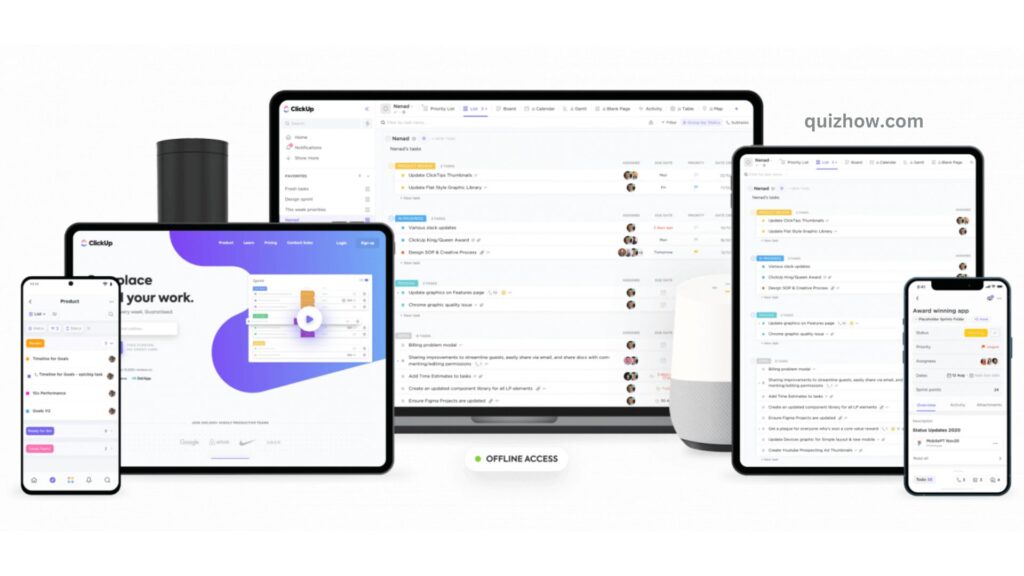
ClickUp is one of the top-rated task automation and project management tools, trusted by productive teams all over the world. With ClickUp, you can set recurring meeting reminders, automatically assign tasks, update statuses, post comments, and much more.
So, what makes ClickUp the best on our list? Let’s break it down.
ClickUp’s smart automation features not only cut down on manual work, but they also free up your resources so you can focus on more creative tasks. Here’s how it works: when a certain trigger happens and meets a condition, ClickUp takes care of the next step by automatically performing a specific action.
Think of it like this: Remember EVE from WALL-E? Her mission was simple:
- If she found a plant on Earth,
- she’d store it in her chest cavity,
- then shut down.
With ClickUp, you could automate EVE’s task by setting up these three key parts:
- Trigger: finding a plant
- Condition: it’s on Earth
- Action: store it and shut down
All of that, and you don’t need to know any coding!
While you can create your own custom automations like the one we mentioned, ClickUp also offers over 50 pre-built automations to help you get started right away.
Here are some handy ways you can automate tasks:
- Automatically assign tasks to team members
- Add a tag to tasks when their priority changes
- Update task status when the due date arrives
- Post a comment whenever the task status or assignee changes
But that’s just the beginning! Here’s why ClickUp is an excellent automation solution:
- Recurring tasks: Set tasks to repeat automatically so you never miss anything important
- Task reminders: Turn any comment or notification into a reminder
- Custom task statuses: Create different stages for tasks to keep track of your team’s progress
- Form view: Automatically send form responses to a specific list
- Gantt charts: Get a clear overview of tasks to manage deadlines, track dependencies, and resolve bottlenecks
- Assigned comments: Quickly assign action items to teammates via comments
- Task checklists: Keep track of routine tasks with easy-to-use checklists
- Task dependencies: Set task order with “blocking” or “waiting on” options
- Due dates: Set deadlines for tasks, subtasks, or lists
- Email in ClickUp: Automatically send emails based on custom fields, form submissions, or task updates
- Integrations: Choose from over 1,000 integrations to streamline your workflow
ClickUp Pricing:
- Free Forever Plan: Ideal for personal use
- Unlimited Plan: Great for small teams ($7/member per month)
- Business Plan: Perfect for mid-sized teams ($12/member per month)
- Enterprise Plan: Contact ClickUp for custom pricing
ClickUp User Ratings:
- G2: 4.7/5 (3,280+ reviews)
- Capterra: 4.7/5 (2,260+ reviews)
2. Tallyfy
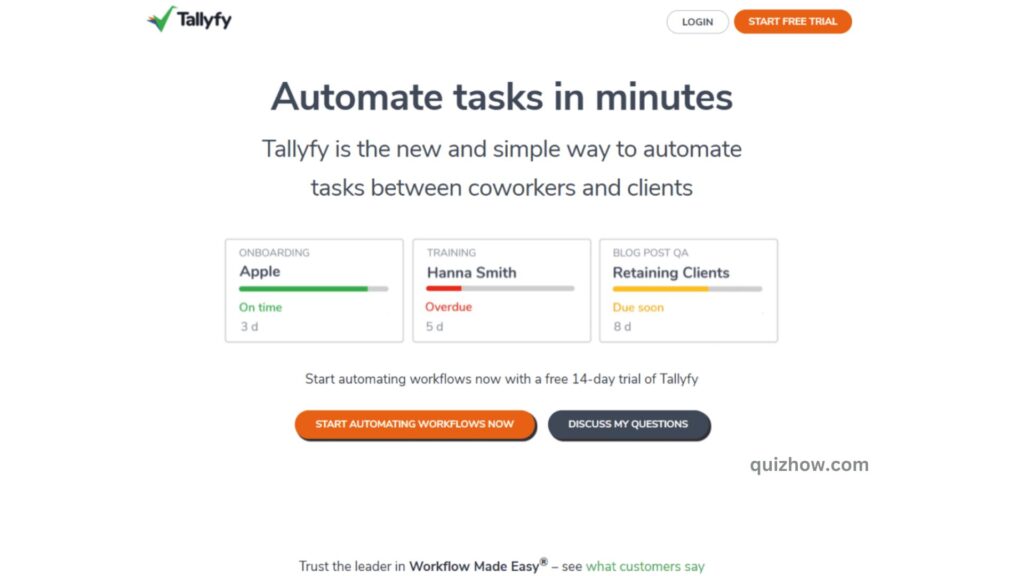
Tallyfy is a handy automation tool that helps you automate everyday tasks without needing to code or deal with complicated flowcharts. For example, you can set it to show or hide tasks based on specific rules.
However, the customization options for the user dashboard are a bit limited—so you might not be able to organize your automation exactly how you’d like.
Tallyfy Key Features:
- Assign tasks and forms for data collection
- Use the ‘report issue’ feature to organize chat conversations
- Set rules to automatically hide or show tasks
- Create and manage data with structured form fields
Tallyfy Pricing:
Plans start at $5 per user per month.
Tallyfy Customer Ratings:
- G2: Not available
- Capterra: 4.3/5 (5+ reviews)
3. Zoho Flow
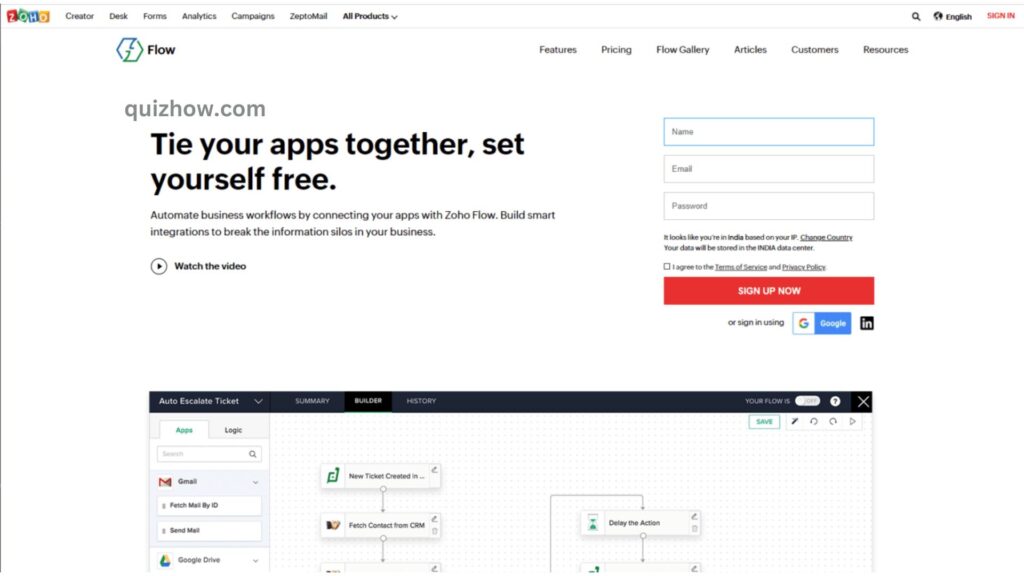
Zoho Flow is great for automating business processes and breaking down information silos. It helps you connect your important apps and create automated, multi-step workflows.
However, its downside is that it doesn’t offer many integration options outside the Zoho ecosystem. So, if you rely on a variety of apps, you might need to look into other automation tools that offer more flexibility.
Zoho Flow Key Features:
- Use Zoho Flow’s logic feature to build smart workflows
- Utilize Deluge (Zoho’s scripting language) to transfer data between apps
- Access a centralized log to track the history of all workflows
- View all business processes and key metrics on a single dashboard
Zoho Flow Pricing:
Plans start at $10 per month.
Zoho Flow Customer Ratings:
- G2: 3.9/5 (10+ reviews)
- Capterra: 4.2/5 (5+ reviews)
4. Jira
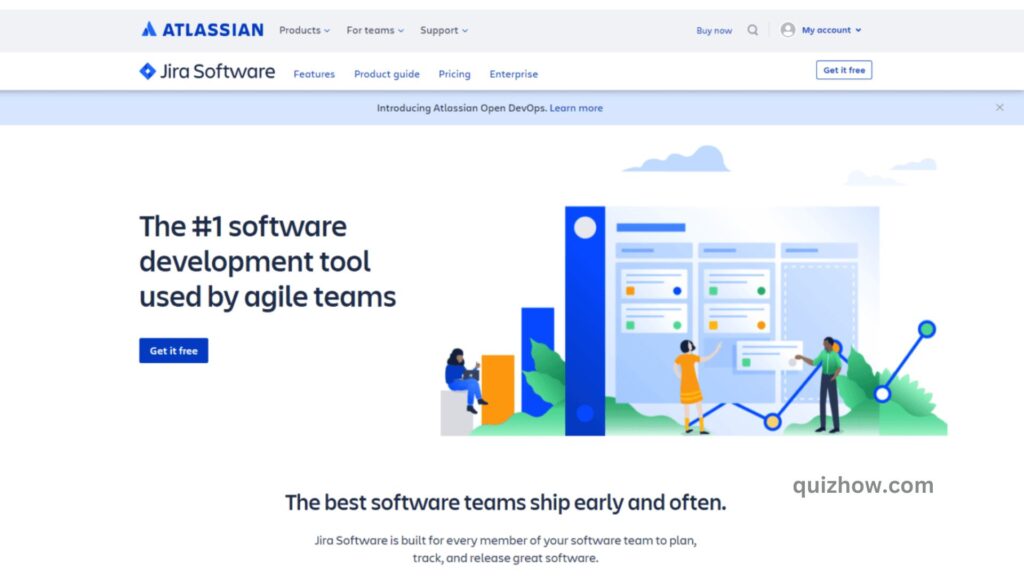
Jira is a task automation tool that makes it easy to set up rules with just a few clicks. For example, you can automatically close subtasks, assign issues to engineers, and schedule different tasks.
One downside, though, is that you can’t assign multiple users to the same issue, so some tasks will still need to be handled manually.
Key Features of Jira:
- A wide variety of automation templates
- Sandbox and release tracks for managing product updates
- Automation rules that can apply across multiple projects
- Integrations with popular tools like Slack, GitHub, and more
Jira Pricing:
Jira is free for up to 10 users, with paid plans starting at $7 per user per month.
Jira Customer Ratings:
- G2: 4.2/5 (3,900+ reviews)
- Capterra: 4.4/5 (10,600+ reviews)
5. Wrike
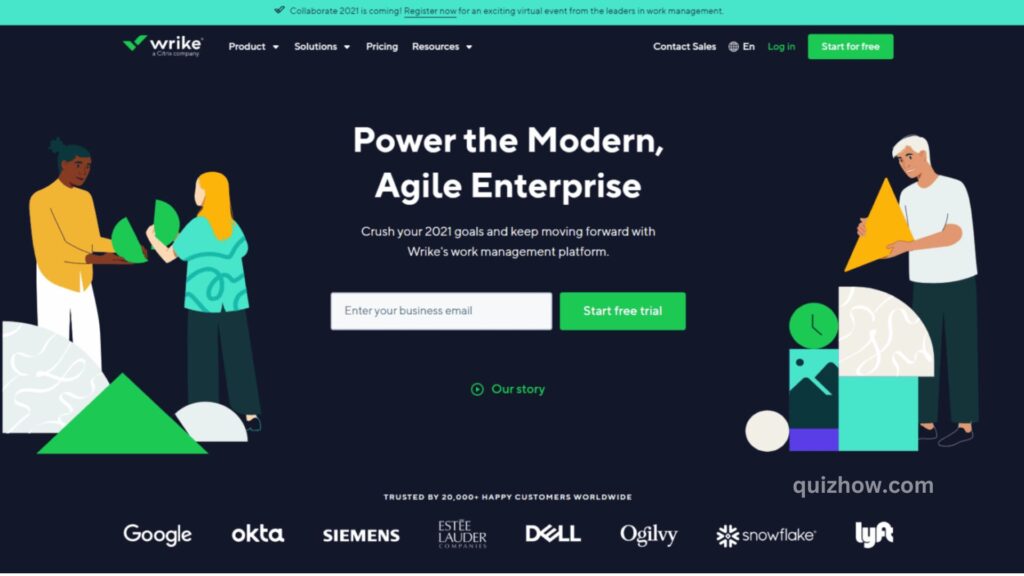
With Wrike, you can set up team-specific automations to make your business processes smoother. You can also use digital publishing and shared team calendars to keep track of deadlines and speed up feedback.
One downside is that the Wrike mobile app isn’t very popular with users.
Key Features of Wrike:
- Customizable dashboards and request forms
- Visual proofing and automated approval systems
- AI-driven automation and project risk predictions
- Custom forms to automatically create and assign tasks
Wrike Pricing:
Wrike has a free plan, and paid plans start at $9.80 per user per month.
Wrike Customer Ratings:
- G2: 4.2/5 (1,670+ reviews)
- Capterra: 4.2/5 (1,670+ reviews)
6. LeapWork
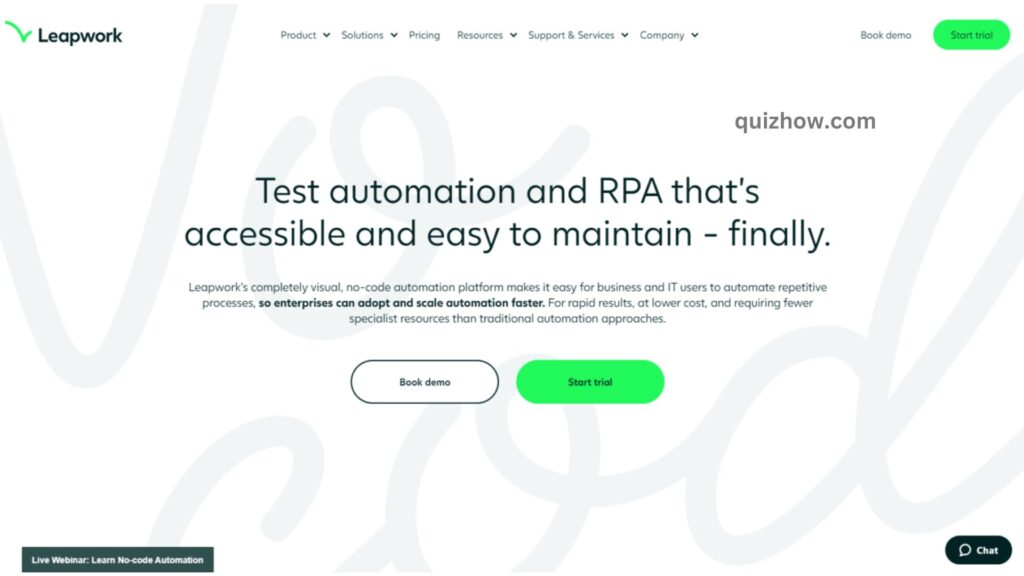
If you’re into robotic process automation or test automation, give LeapWork a try. It’s a no-code tool with an easy-to-understand process automation language that’s great for scaling up.
The catch? Debugging complex workflows can be a bit challenging.
You’ll need to take a leap of faith with LeapWork.
Key Features of LeapWork:
- Works with web and desktop applications on any platform
- Clear, visual representation of bugs
- Advanced calendar to help you see all your tasks
- Manage workflows and assign tasks efficiently
LeapWork Pricing:
Pricing details are available upon request.
LeapWork Customer Ratings:
- G2: 4.4/5 (10+ reviews)
- Capterra: 4.4/5 (40+ reviews)
7. ProcessMaker
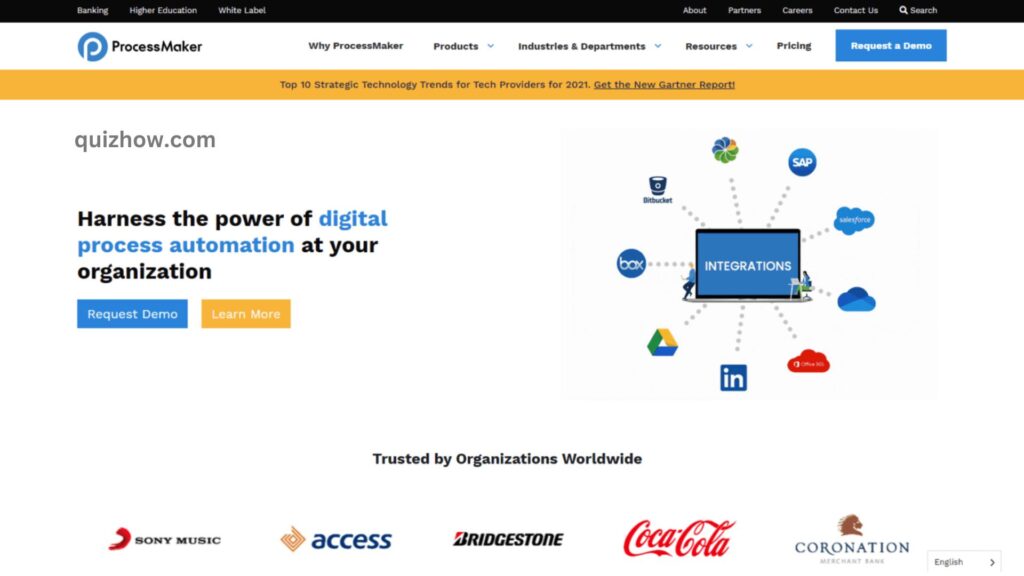
ProcessMaker is a handy tool for automating repetitive tasks like forms and approval processes across different departments. You can connect it to other systems via API and use robotic process automation for even more functionality.
On the downside, adding new automated processes can be a bit tricky with ProcessMaker.
Key Features of ProcessMaker:
- A business process modeler to drag and drop tasks and decision points
- Dashboards to keep an eye on processes
- No-code forms and display screens
- Approve or reject requests straight from your email inbox or Slack
ProcessMaker Pricing:
The standard premium version costs $1,495 per month (billed annually).
ProcessMaker Customer Ratings:
- G2: 4.3/5 (240+ reviews)
- Capterra: 4.5/5 (170+ reviews)
8. Pipefy

With Pipefy, you don’t need any coding skills to automate your workflows or business processes. It’s designed to make request management easier, set up digital workflows, and cut down on errors by automating manual tasks.
Key Features of Pipefy:
- Custom integrations for everything from chat apps to ERPs
- Service portals to centralize documents, policies, and request forms
- Automated emails with ready-to-use templates
- Advanced reporting to filter and combine data from your processes
Pipefy Pricing:
There’s a free plan available, and paid plans start at $22 per user per month.
Pipefy Customer Ratings:
- G2: 4.6/5 (170+ reviews)
- Capterra: 4.6/5 (260+ reviews)
9. Zapier
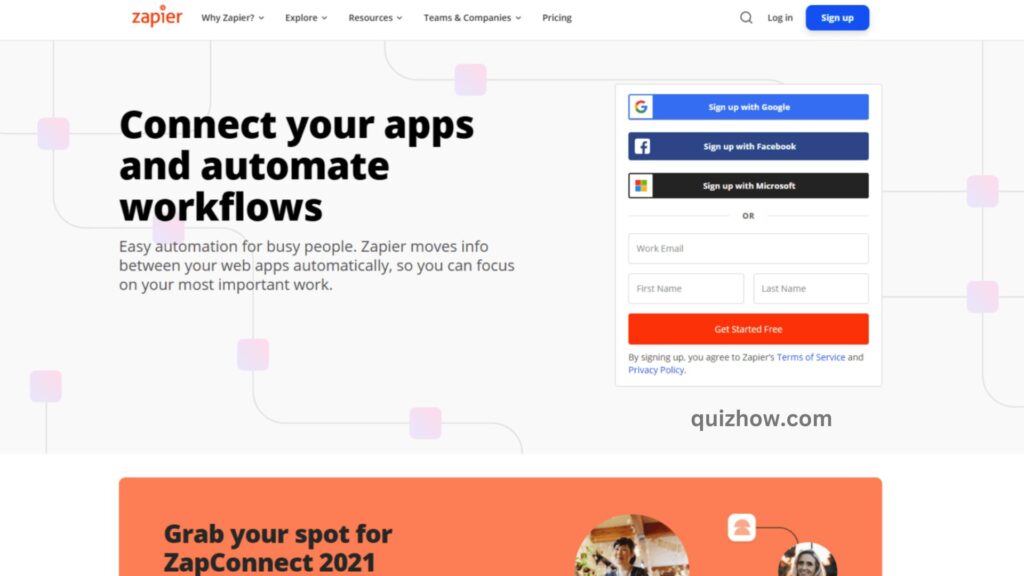
Zapier is great for connecting over 750 apps and automating tasks with just a few clicks. It’s perfect for integrating, automating, and getting creative.
On the flip side, setting up these integrations can get pretty complicated, and you might end up feeling a bit overwhelmed.
Key Features of Zapier:
- Automate multiple tasks with a single trigger
- Use filters to set the rules for your automations
- Keep track of your automation history with Zap history
- Access a variety of automated workflow templates
Zapier Pricing:
Zapier offers a free plan, and paid plans start at $29.99 per month.
Zapier Customer Ratings:
- G2: 4.5/5 (740+ reviews)
- Capterra: 4.7/5 (1,800+ reviews)
10. RoboTask
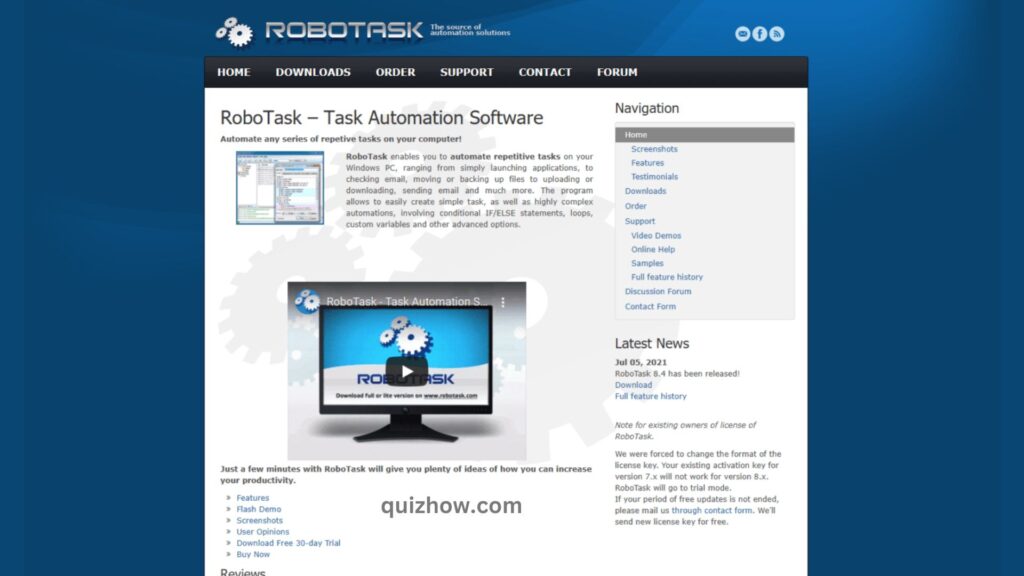
Since Windows doesn’t come with a macro recorder, RoboTask steps in as a desktop automation tool made just for Windows PCs. It lets you record mouse and keyboard actions to automate your tasks.
The catch? Its interface might seem a bit intimidating and outdated, so it might take some time to get used to it.
Key Features of RoboTask:
- Automatically runs applications and opens documents
- Manages automatic backups
- Sends emails with letters and files
- Functions as an alarm clock
RoboTask Pricing:
RoboTask is priced at $150 per license.
RoboTask Customer Ratings:
- G2: Not available
- Capterra: Not available
11. Alfred
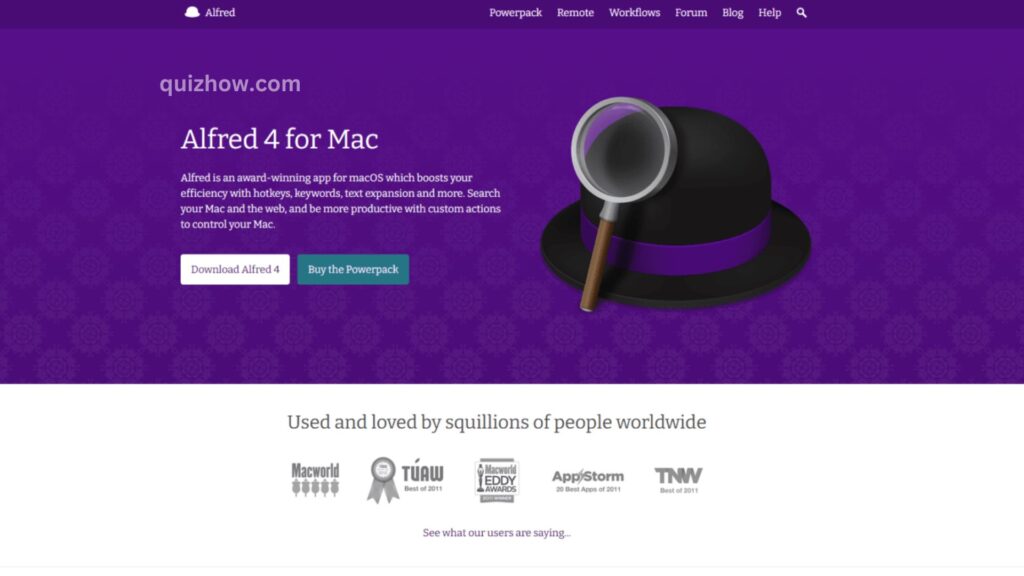
Alfred is a great workflow automation tool for Mac users. It lets you use hotkeys to navigate your interface or set up automated workflows with your keyboard.
One downside is that Alfred’s community support for plugins isn’t the best.
Key Features of Alfred:
- Clipboard history: Quickly find any text, image, or file you’ve copied
- Powerpack: Create custom automated workflows
- Deep macOS integration: Execute system commands easily
- File buffer: Select and act on multiple files at once
Pricing:
You can download Alfred for free. For details on paid plans, you’ll need to contact their sales team.
Customer Ratings:
- G2: 4.4/5 (20+ reviews)
- Capterra: Not available
12. Kissflow
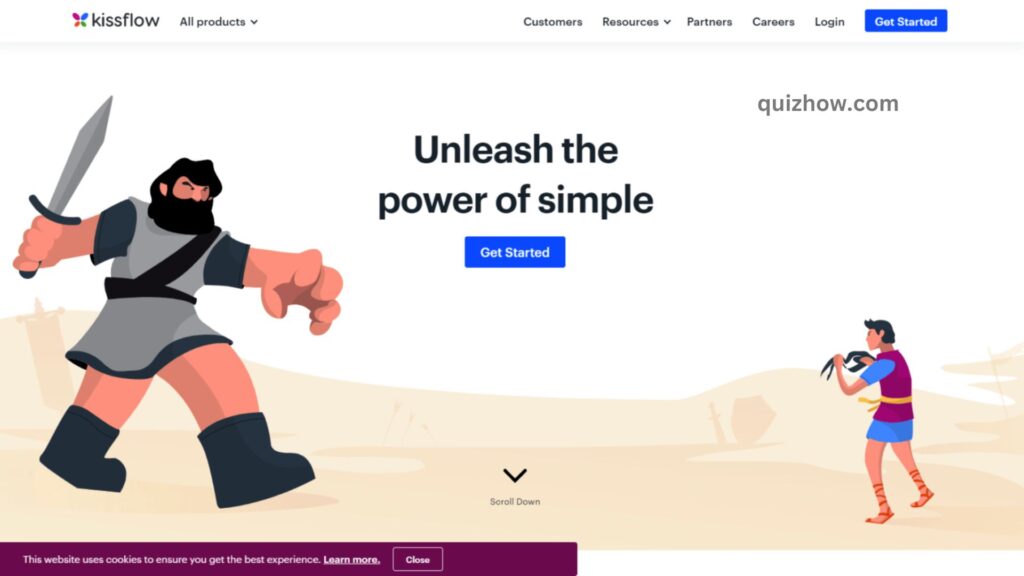
Kissflow is a business process management and workflow automation tool that lets you customize any process without needing coding skills.
One downside is that migrating processes to Kissflow can be a bit tricky.
Key Features of Kissflow:
- Drag and drop forms to create apps
- Real-time analytics for automated processes
- Manage processes and workflows without any coding
- Scales up to handle large amounts of data and complex tasks
Pricing:
Kissflow starts at $12 per user per month.
Customer Ratings:
- G2: 4.3/5 (470+ reviews)
- Capterra: 3.8/5 (10+ reviews)
Also Read: 10 Tips to Prevent Phishing Attacks
13. Integrify

Integrify is automation software that lets you design your process apps with forms, service portals, and reports.
On the downside, building complex workflows or business processes can be pretty challenging with this tool.
Key Features of Integrify:
- Form designer to create reusable forms
- Free pre-built process apps ready to use
- Customized notifications, reminders, and escalations
- Customizable reports and dashboards
Pricing:
Pricing details for Integrify are available upon request.
Customer Ratings:
- G2: 4.4/5 (30+ reviews)
- Capterra: 4.5/5 (10+ reviews)
14. Gravity Flow
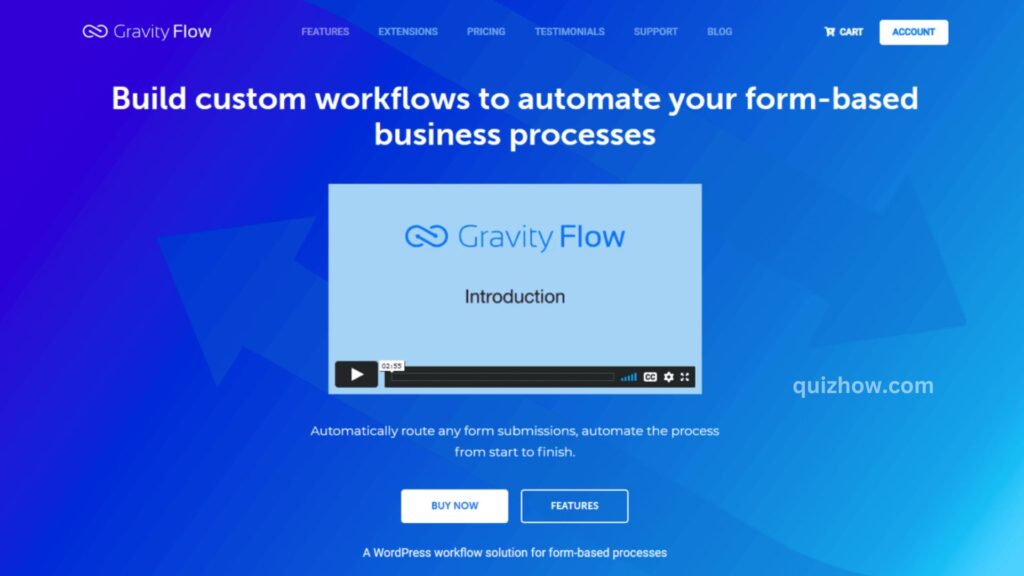
Gravity Flow is a WordPress plugin that helps you create custom workflows to automate form-based processes and cut down on human error. For instance, you can use it to handle vacation requests, admission forms, purchase orders, and more.
However, its high cost might make it a bit tough to choose Gravity Flow.
Key Features of Gravity Flow:
- Over 40 ready-to-use steps for designing workflows
- Easy drag-and-drop process builder
- Detailed reports on tasks and any bottlenecks
- Audit trail to track a detailed timeline and activity log
Pricing:
Gravity Flow starts at $99 per year.
Customer Ratings:
- G2: Not available
- Capterra: Not available

15. Flokzu
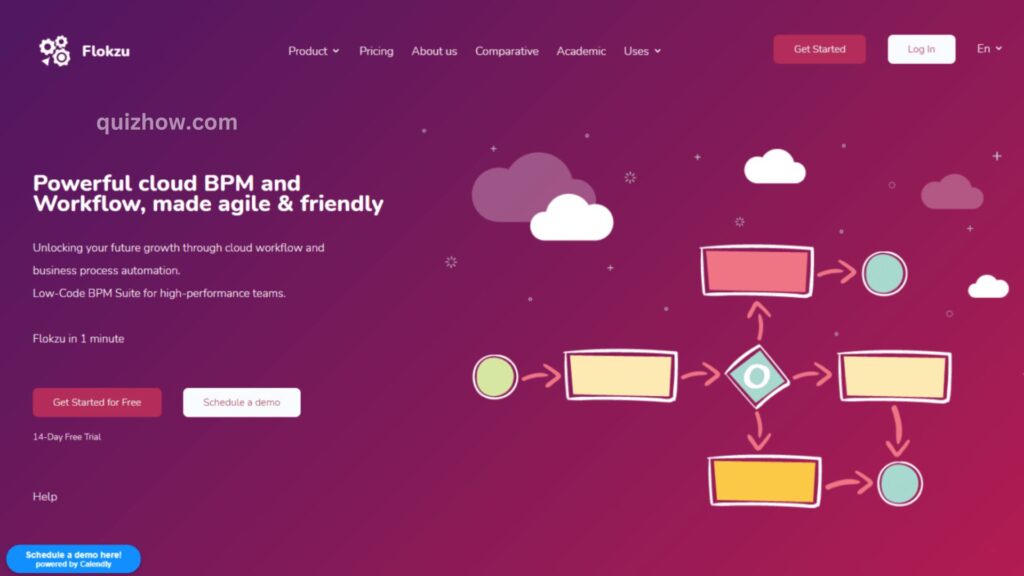
Flokzu is a tool for business process management and workflow automation. It lets you use a drag-and-drop interface to set up tasks, business rules, deadlines, and more.
However, it has a limitation: the drag-and-drop feature doesn’t handle workflows with multiple branching paths very well. So, getting everything right might be a bit hit or miss.
Key Features of Flokzu:
- Timers and due dates to enforce deadlines
- Customizable reports
- Automatic database updates using information from APIs
- Automated emails
Pricing:
Flokzu starts at $15 per user per month.
Customer Ratings:
- G2: 4.9/5 (20+ reviews)
- Capterra: Not available
16. Nintex
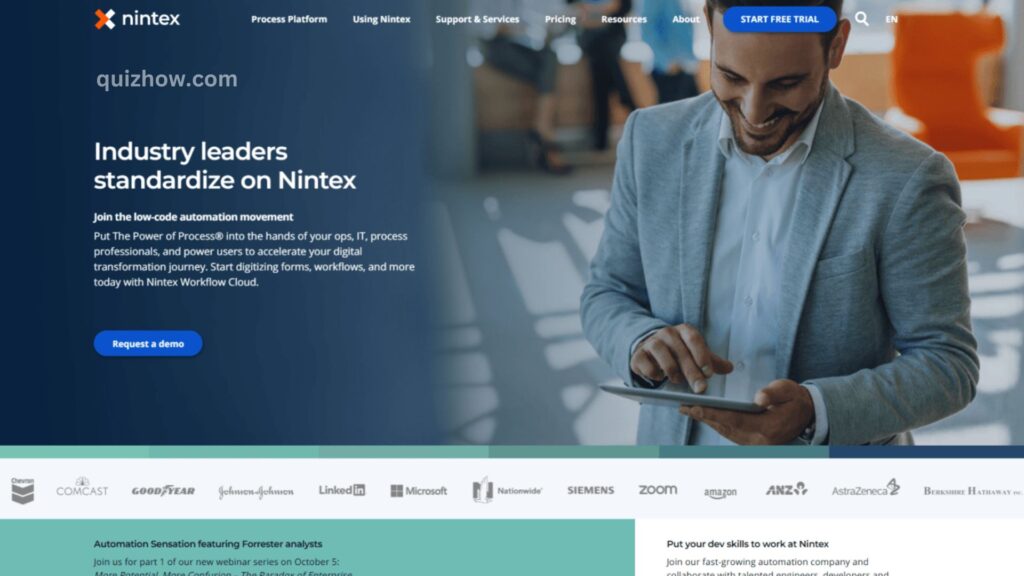
Nintex is a user-friendly automation tool that helps you manage and improve any business process. It comes with a drag-and-drop connector, making it easy to visualize even the most complex processes.
Key Features of Nintex:
- Robotic process automation for handling repetitive tasks
- DocGen® for creating and sharing documents in Salesforce or Office 365
- Online forms for capturing and submitting data
- K2 Cloud software for designing automated workflows visually
Pricing:
Nintex starts at $910 per month.
Customer Ratings:
- G2: 4.2/5 (660+ reviews)
- Capterra: 4.1/5 (70+ reviews)
17. Trello

Trello is a popular tool for project management and teamwork that also includes built-in automation for routine tasks. As your team grows, you can add more features to fit your needs.
One thing to note is that Trello’s automation only works when you’re online, so be prepared for some downtime.
Key Features of Trello:
- Use natural language commands to automate tasks
- Set due date commands to trigger actions
- Schedule actions with calendar commands
- Create custom buttons to streamline processes
Pricing:
Trello offers a free plan, and paid plans start at $6 per user per month.
Customer Ratings:
- G2: 4.4/5 (11,870+ reviews)
- Capterra: 4.5/5 (19,770+ reviews)

18. Make
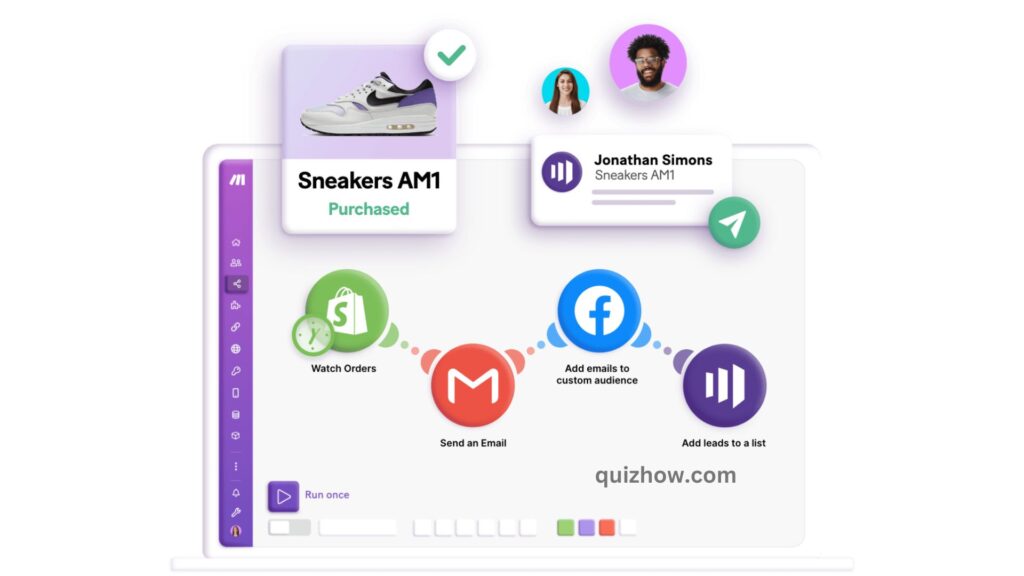
Make (formerly known as Integromat) is a top-notch visual platform that lets you design, build, and automate everything from tasks and workflows to apps and systems—no coding needed!
With Make, individuals, teams, and businesses can create custom solutions that help scale their operations quickly and efficiently.
Key Features of Make:
- Create multi-step scenarios with branching logic
- Use a range of automation tools like filters, iterators, and error handlers
- Access over 1,000 apps and 6,000 endpoints
- Connect to any API using its HTTP module
Pricing:
Make offers a forever-free plan with 1,000 operations per month. Paid plans start at $9 per month.
Customer Ratings:
- G2: 4.8/5 (160+ reviews)
- Capterra: 4.8/5 (230+ reviews)
Task Automation Examples
Marketing Campaign Task Automations
Marketing teams handle big outreach campaigns aimed at getting new users and keeping current ones engaged. With so many projects and strategies running at once, marketing automation and task tracking can really help keep things organized.
Marketing teams often use automation software to streamline:
- Email marketing flows and drip campaigns
- Subscription and monthly newsletters
- Social media marketing
- Blog and content scheduling
Invoice Task Automations
If you’re managing invoices for your business, automation software can be a game changer for staying organized.
It can send automatic reminders when you need to send invoices via email and can also handle:
- Scheduling and sending recurring invoices
- Tracking whether invoices have been paid
HR Task Automations
HR departments juggle a lot of repetitive tasks.
Automation software can help HR teams with:
- Screening potential candidates
- Managing employee benefits
- Scheduling appointments
- Handling administrative tasks

Discover more from QuizHow
Subscribe to get the latest posts sent to your email.

